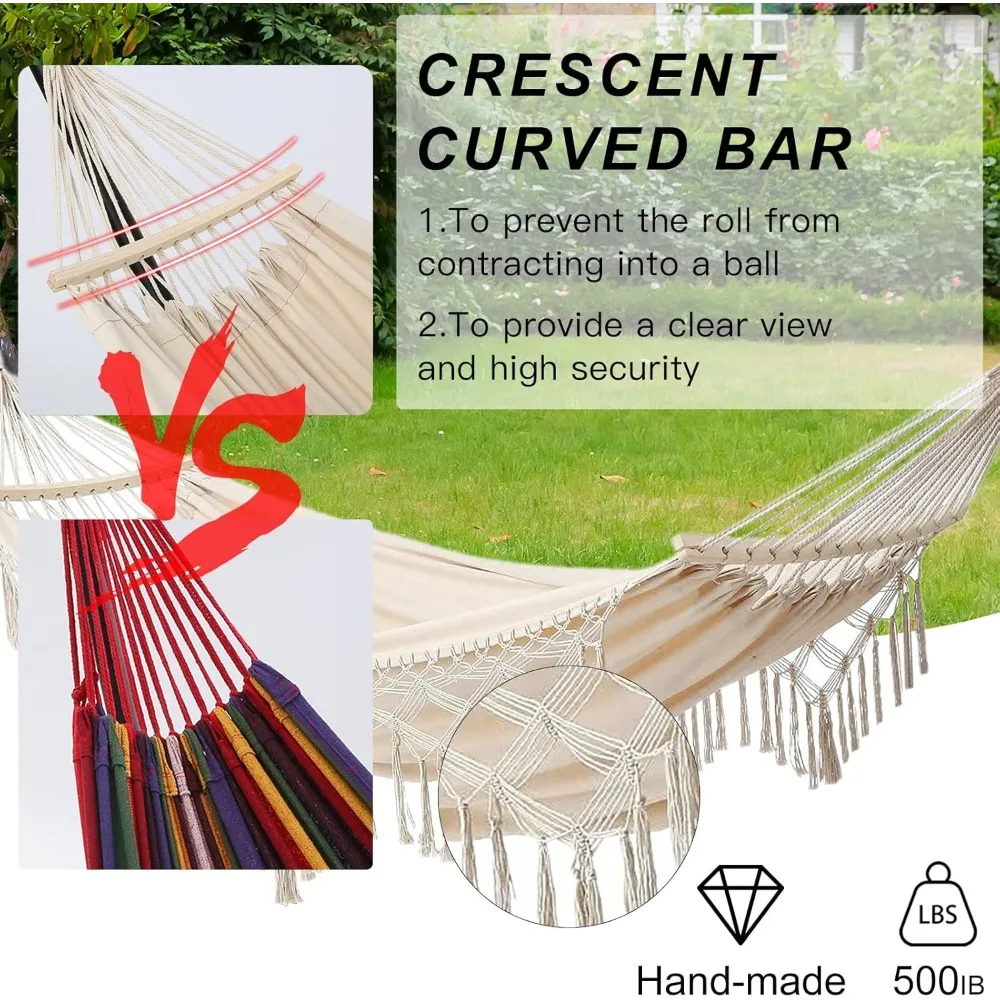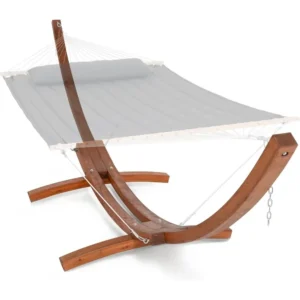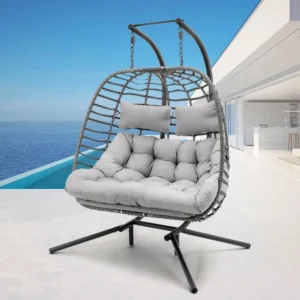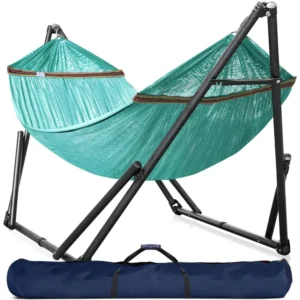Why the Right Location for Your Porch Swing Hammock Matters
The location of your porch swing hammock isn’t just a matter of where it fits—it’s about creating an experience that nurtures both body and soul. The perfect spot transforms an ordinary hammock into a personal sanctuary where comfort, convenience, and aesthetics come together seamlessly.
When thoughtfully positioned, your swing becomes more than a piece of furniture; it becomes a destination. Studies consistently show that dedicated relaxation spaces in our homes significantly reduce stress levels and improve overall well-being. The right location ensures:
- Maximum comfort through proper sun exposure, breeze access, and ambient sound
- Optimal safety with appropriate structural support and clearance
Beyond physical considerations, placement affects how often you’ll use your swing. A conveniently located hammock invites daily moments of pause, while one tucked away might be forgotten. As you consider where to place your new retreat, remember that comprehensive porch swing hammock guides can provide valuable insights into creating your perfect relaxation zone.
Essential Placement Factors to Consider Before Installation
Structural Support Requirements
Before hanging your dream swing, verify that your chosen location can safely bear the load. Porches, beams, and ceiling joists must support not just the weight of the hammock and occupants but also the dynamic force created during swinging motion—generally 250-400 pounds (113-181 kg).
Space and Clearance
Allow ample room for a full swinging arc—at least 3-4 feet (0.9-1.2 meters) in both front and back of the swing. Side clearance of 2 feet (0.6 meters) prevents collisions with walls or railings. Headroom is equally important; most installations need at least 7-8 feet (2.1-2.4 meters) of vertical space.
Weather Exposure
Consider seasonal sun patterns, prevailing winds, and rain exposure. Southern-facing locations receive more sunlight, while western placements catch afternoon sun and may become uncomfortably warm. Tree coverage provides natural shade but may limit your view and drop debris on your swing.
Privacy and View
Balance privacy with the opportunity to enjoy pleasing views. A swing facing a garden or landscape feature enhances relaxation, while strategic positioning can shield you from neighbor sightlines or street traffic.
Traffic Flow
Position your hammock where it won’t obstruct natural pathways but remains easily accessible. An awkwardly placed swing disrupts household movement patterns and ultimately gets used less frequently.
Aesthetic Integration
Choose a location that complements your home’s architecture and outdoor design scheme. The best placements look intentional, as if the space was designed specifically for your swing. Detailed installation requirements can help ensure your chosen spot meets all necessary criteria.
Front Porch Placement: Creating Curb Appeal & Social Connection
Front porch swing hammocks offer a unique blend of visibility, community engagement, and decorative charm. This traditional placement creates an inviting facade that enhances your home’s character while providing a front-row seat to neighborhood activity.
Benefits of Front Porch Placement
- Creates welcoming curb appeal and a lived-in ambiance
- Facilitates casual interactions with neighbors and passersby
- Offers street views and connection to community life
- Typically provides good structural support via existing porch beams
Position your front porch swing asymmetrically rather than centered to create visual interest and allow easier passage. Ideally, place it 3-4 feet (0.9-1.2 meters) from your front door to maintain accessibility while creating a distinct relaxation zone.
For homes with wrap-around porches, corner placements often provide the best combination of visibility and partial privacy. Consider how morning and afternoon sun will affect comfort throughout the day, and remember that specially designed porch swing chair sets can enhance the traditional charm of front porch settings.
Back Porch & Patio Locations: Privacy & Extended Living Space
Back porch and patio placements offer greater seclusion while extending your living space into the outdoors. These locations balance privacy with the pleasure of open-air relaxation, making them perfect for reading, conversation, or quiet contemplation.
A back porch swing creates a natural focal point that defines your outdoor living area. Consider these placement strategies:
- Position the swing to face garden features or landscape views
- Install near but not directly adjacent to outdoor dining areas (maintain at least 6 feet/1.8 meters separation)
- Create a transition zone between indoor and outdoor spaces
- Use overhead structures for shade while maintaining airflow
Back porch installations often benefit from ceiling fans placed nearby to enhance air circulation during warmer months. If privacy is paramount, consider installing the swing in a corner with strategic plantings or screens.
For patios without overhead structures, freestanding options provide flexibility. The right placement can transform your ordinary backyard into a private hammock haven where you can escape without leaving home.
Garden & Yard Installations: Creating Nature-Immersed Retreats
Garden swing placements offer an immersive nature experience, surrounding you with the sights, sounds, and scents of your outdoor sanctuary. These installations feel more adventurous and removed from the home’s architecture, creating destination spots within your landscape.
Tree-Mounted Options
Mature trees with healthy, horizontal branches of at least 8 inches (20 cm) in diameter can support swing hammocks. Look for these indicators of suitable trees:
- No signs of disease or decay
- Minimal deadwood in the canopy
- Stable root systems with no recent exposure
- Species known for strength (oak, maple, hickory)
Dedicated Structures
Pergolas, arbors, and free-standing frames provide reliable support while enhancing garden aesthetics. When positioning these structures:
- Place along garden pathways to create natural pauses
- Orient toward flowering beds or water features
- Consider seasonal sun patterns for comfortable use
- Install on level ground with proper foundation support
Garden swings benefit from surrounding greenery that creates a sense of enclosure without feeling confined. Low plantings around the base add dimension, while climbing vines on supporting structures enhance the natural feel.
For yard installations where anchoring may be challenging, understanding strongest materials for hammock stands will help ensure safety and stability in your garden retreat.

Covered Structures: Pergolas, Gazebos & Pavilions
Dedicated outdoor structures provide ideal mounting points for porch swing hammocks while extending their seasonal usability. These installations combine the openness of outdoor settings with protection from harsh elements.
Pergola Placements
Pergolas offer partial shade through slatted roofing while maintaining an airy feel:
- Center the swing within the structure for balanced aesthetics
- Allow 2 feet (0.6 meters) clearance from all pergola posts
- Consider adding weather-resistant curtains for adjustable privacy
- Ensure beam dimensions of at least 6×6 inches (15×15 cm) for adequate support
Gazebo Installations
Fully-roofed gazebos provide excellent protection from sun and rain:
- Position swings against railings for maximum floor space utilization
- Install facing the most appealing view or central yard area
- Ensure 7-foot (2.1-meter) minimum ceiling height for comfortable headroom
- Consider octagonal gazebos for multiple swing installations
Pavilion Options
Open-sided pavilions combine generous overhead protection with unobstructed views:
- Center swings under the highest point of peaked roofs
- Allow more clearance for wider swinging arcs in these spacious structures
- Consider ceiling fans for air circulation in enclosed designs
All covered structures require proper anchoring, with footings extending below the frost line. For maximum stability and safety, explore heavy-duty hammock stands designed specifically for these semi-permanent installations.
Poolside & Water-Adjacent Placements
Positioning a porch swing hammock near water features creates a resort-like atmosphere in your own backyard. These placements combine the soothing qualities of water with the gentle motion of swinging for ultimate relaxation.
When installing poolside swings, safety becomes paramount:
- Maintain minimum distance of 4 feet (1.2 meters) from pool edges
- Choose locations away from diving boards or slides
- Install on stable, non-slip surfaces
- Ensure all hardware is corrosion-resistant (marine-grade preferred)
For aesthetic impact, position your swing to frame water views rather than blocking them. Consider the angle of the sun throughout the day—eastern exposures provide morning relaxation without afternoon heat that can make metal hardware uncomfortably hot.
Material selection becomes especially important in humid environments. Look for:
- Quick-drying, mildew-resistant fabrics
- Rust-proof chains and hardware
- UV-stabilized ropes and textiles
- Marine-grade wood or aluminum frames
For maximum comfort in sunny poolside locations, hammock sets with canopies provide essential shade while adding a touch of resort luxury to your water-adjacent relaxation space.
Balconies & Small Spaces: Maximizing Limited Areas
Limited square footage doesn’t mean foregoing the pleasure of a porch swing hammock. With careful placement and scaled-down options, even compact balconies and patios can accommodate these relaxation essentials.
Space Optimization Strategies
- Choose corner placements to maximize remaining usable space
- Consider wall-mounted folding options that can be tucked away when not in use
- Use L-shaped or custom-sized swings designed specifically for tight areas
- Ensure 24 inches (61 cm) minimum clearance from walls and railings
For balconies, structural considerations become critically important. Before installation:
- Verify weight limits with building management (typically 50-75 pounds per square foot/244-366 kg per square meter)
- Identify load-bearing attachment points, avoiding decorative elements
- Use shorter chains to reduce swinging arc where space is limited
- Consider distributing weight with additional mounting points
Small spaces benefit from multi-functional approaches—look for swings with built-in storage or side tables that eliminate the need for additional furniture. Achieving perfect porch swing hammock comfort in smaller spaces often means choosing more compact designs with thoughtful cushioning.
Indoor Havens: Year-Round Porch Swing Enjoyment
Bringing porch swing hammocks indoors extends their enjoyment throughout all seasons while creating distinctive interior design elements. These unexpected indoor additions become immediate conversation pieces that invite relaxation regardless of weather.
Sunroom and Conservatory Placements
These transitional spaces offer abundant natural light while providing full climate control:
- Position to maximize view of outdoor landscapes
- Allow 3 feet (0.9 meters) clearance from glass walls
- Consider ceiling height for proper proportion and clearance
- Use ceiling joists or reinforced mounting points for secure installation
Living Area Installations
In main living spaces, swings become functional art pieces:
- Replace traditional seating in reading nooks
- Use as unique focal points in conversation areas
- Position near but not blocking natural light sources
- Ensure installation doesn’t interfere with traffic patterns
Bedroom and Private Spaces
Bedroom swings create peaceful retreats within retreats:
- Position near windows for morning light and views
- Consider more compact designs for smaller bedrooms
- Use as alternatives to traditional reading chairs
- Install with noise-dampening hardware for quiet operation
All indoor installations require careful structural assessment. Secure mounting requires:
* Locating and anchoring directly to ceiling joists or beams
* Using lag bolts or through-bolts rather than hooks
* Reinforcing standard joists with sister joists or blocking
* Consulting professionals for load distribution questions
Understanding the differences between indoor and outdoor hammock installations helps ensure safety, comfort, and longevity in your indoor swing placement.
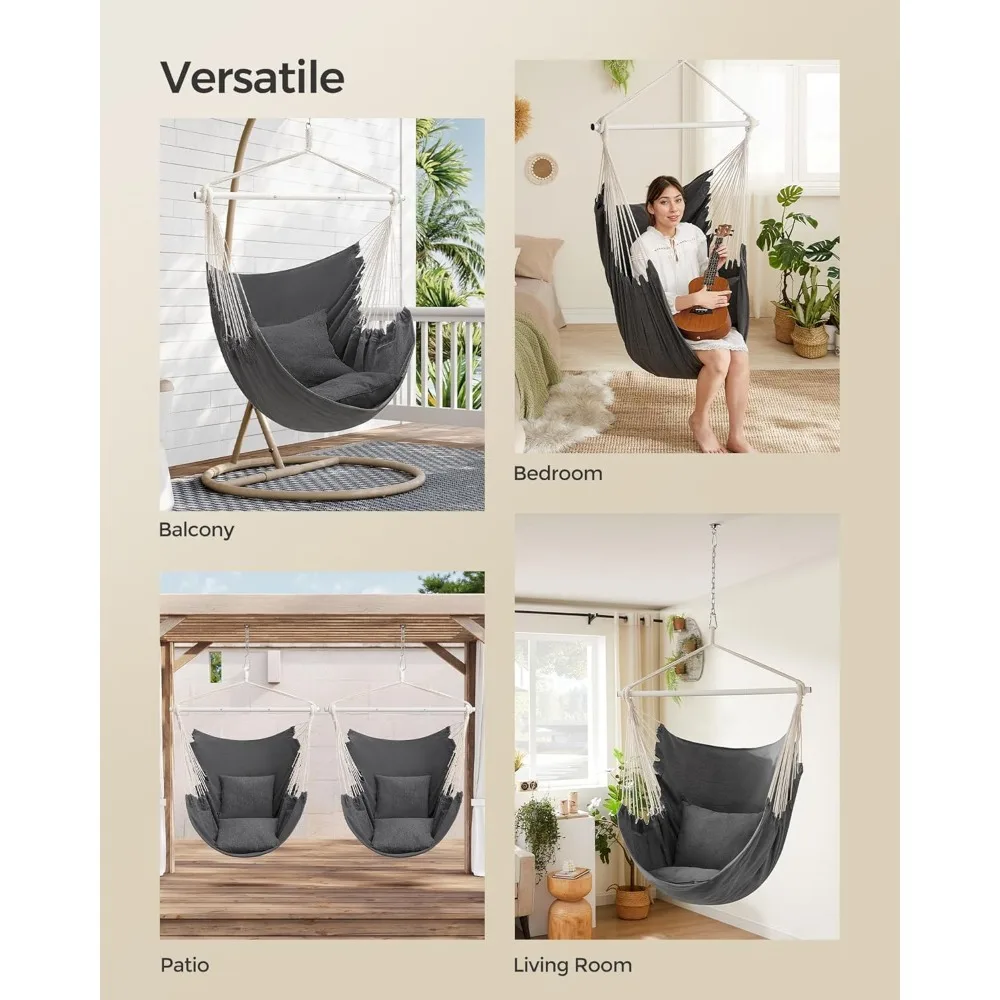
Installation Safety & Support Requirements
Regardless of location, proper installation ensures both safety and enjoyment of your porch swing hammock. Following these guidelines helps prevent structural failures and accidents.
Verify Support Strength: Ensure mounting points can support at least 600 pounds (272 kg)—significantly more than anticipated static weight to account for dynamic forces during use.
Use Appropriate Hardware: Select hardware rated for outdoor use if applicable:
* Stainless steel or galvanized eye bolts (minimum 3/8-inch/10mm diameter)
* S-hooks or carabiners rated for at least 300 pounds (136 kg)
* Chains or ropes with breaking strength of 800+ pounds (363+ kg)Secure Mounting Technique: Drive lag bolts or through-bolts into structural members, never into decorative elements or facade materials.
Regular Inspection Schedule: Check all components monthly during heavy use seasons and quarterly during off-seasons.
Professional Assessment: When uncertain about structural capacity, especially for ceiling joists or porch beams, consult with a structural engineer.
For larger individuals or family use, heavy-duty hammock sets provide reinforced components specifically designed to support higher weight capacities with enhanced safety margins.
Freestanding Options: Swing Stands & Portable Solutions
When permanent installation isn’t possible due to structural limitations, rental restrictions, or the desire for flexibility, freestanding stands offer excellent alternatives. These self-supporting systems can be placed virtually anywhere with sufficient clearance and stable footing.
Stand Material Comparison
| Material | Advantages | Best Applications |
|---|---|---|
| Steel | Higher weight capacity (400+ lbs/181+ kg), weather resistant, slimmer profile | Year-round outdoor use, larger swings |
| Wood | Aesthetic appeal, natural look, warm feel, typically more traditional design | Covered areas, design-focused settings |
| Aluminum | Lightweight, rust-resistant, easy to move, modern appearance | Seasonal setups, portable applications |
| Combination | Strength of metal with visual appeal of wood accents | Versatile locations requiring both style and durability |
For optimal stability, place freestanding stands on:
* Level surfaces (use shims if needed for perfect leveling)
* Firm ground that won’t shift or sink
* Paving stones or deck surfaces for added stability
* Protected areas if using less weather-resistant materials
Freestanding systems allow seasonal relocation to follow optimal sun patterns or to accommodate outdoor entertaining needs. For aesthetic appeal combined with stability, wooden arc stand hammock sets offer beautiful curved designs that complement both traditional and contemporary settings.
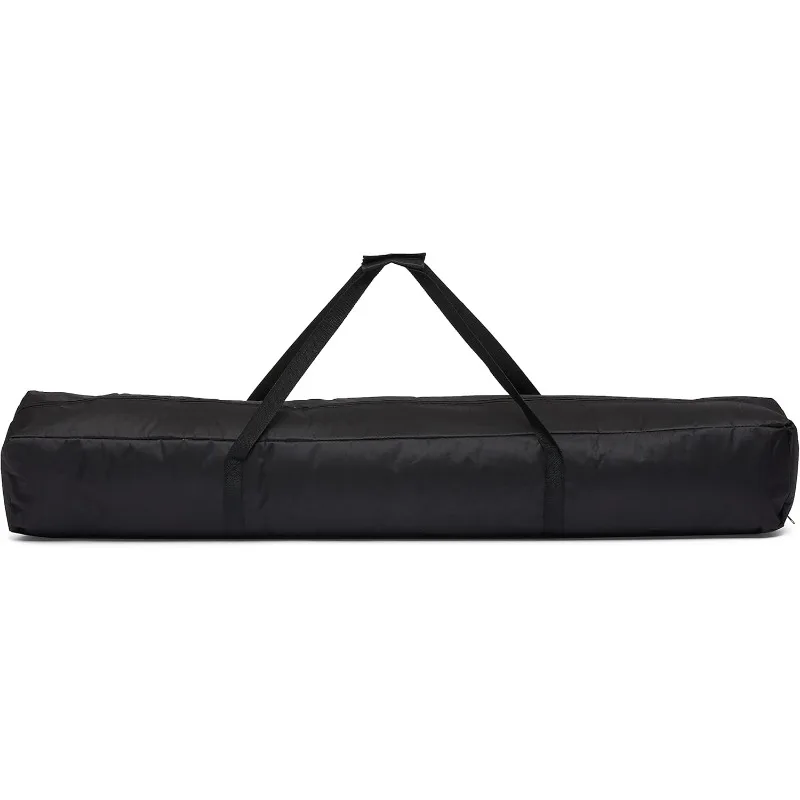
Dark Wood Hammock Sets, Porch Swing Chair Sets
$653.82 Select options This product has multiple variants. The options may be chosen on the product pageClassic Wooden Stand Hammock Sets, Heavy Duty Hammock Sets
$1,061.68 Select options This product has multiple variants. The options may be chosen on the product pageHammock Sets with Canopy, Heavy Duty Hammock Sets
$286.31 Select options This product has multiple variants. The options may be chosen on the product pageHeavy Duty Hammock Sets, Wooden Arc Stand Hammock Sets
$878.66 Select options This product has multiple variants. The options may be chosen on the product page- $963.29 Select options This product has multiple variants. The options may be chosen on the product page
Double / Two Person Hammock Sets, Folding Hammock Sets, Heavy Duty Hammock Sets
Price range: $323.71 through $486.23 Select options This product has multiple variants. The options may be chosen on the product page
How to Enhance Your Chosen Location with Accessories & Landscaping
Once you’ve selected the perfect location for your porch swing hammock, thoughtful enhancements can elevate the experience from merely comfortable to truly exceptional.
Comfort Additions
- Weather-appropriate cushions (water-resistant fabrics like Sunbrella for outdoor locations)
- Throw pillows that complement your home’s color scheme
- Nearby blanket storage for cooler evenings
- Season-appropriate textiles to refresh the look throughout the year
Ambient Lighting
- String lights overhead for gentle evening illumination
- Solar lanterns for eco-friendly pathway lighting
- Battery-operated LED candles for ambiance without fire risk
- Motion-sensor lights for safety in darker locations
Complementary Elements
- Side tables within arm’s reach for books and beverages
- Weather-resistant storage ottomans for dual functionality
- Plant stands with moisture-loving species that thrive in the microclimate
- Outdoor rugs to define the space and add comfort underfoot
Creating dedicated pathways to your swing area not only enhances accessibility but also establishes it as a destination within your landscape. For additional ideas on maximizing your experience, explore various approaches to ultimate relaxation in porch swing hammocks.
Common Placement Mistakes to Avoid
Even with careful planning, certain common errors can undermine the enjoyment of your porch swing hammock. Avoiding these pitfalls ensures maximum satisfaction with your installation.
Insufficient Structural Support: Mounting to decorative elements, fascia boards, or untested tree branches can lead to dangerous failures. Always verify load capacity and use appropriate reinforcement.
Inadequate Clearance: Positioning too close to walls, furniture, or obstacles creates collision hazards and limits the natural swinging motion. Always measure clearance zones before finalizing placement.
Poor Sun Orientation: Installing in full afternoon sun creates uncomfortable heat, while deep shade can encourage mildew. Consider seasonal sun patterns and how they’ll affect comfort throughout the year.
Ignoring Wind Patterns: Locations with constant strong breezes may seem refreshing but can make reading difficult and create excessive motion. Conversely, completely sheltered areas might become stagnant in summer.
Overlooking Privacy Factors: Swings visible from public spaces or neighboring properties may feel exposed and ultimately go unused. Consider sightlines and add screening elements where needed.
Choosing Incompatible Materials: Selecting fabrics and components unsuited to your specific environment leads to premature deterioration. The importance of choosing perfect porch hammock fabric cannot be overstated, as material performance varies dramatically by location.
Frequently Asked Questions About Porch Swing Hammock Placement
What’s the minimum space needed for a porch swing hammock?
For comfortable use, allow at least 14 feet (4.3 meters) of linear space—this accommodates the swing itself (typically 4-5 feet/1.2-1.5 meters) plus the necessary clearance for safe swinging (3-4 feet/0.9-1.2 meters on each side).
Is it safe to hang a swing from a tree branch?
Yes, if the branch is healthy, horizontal, and at least 8 inches (20 cm) in diameter. Look for hardwood trees without signs of disease, and use tree-friendly hanging systems that won’t damage the bark.
What’s the ideal hanging height for a porch swing?
The seat should rest 17-19 inches (43-48 cm) from the ground when unoccupied—this provides comfortable seating height for most adults while allowing feet to touch the ground.
Can I install a swing in my rental property?
Freestanding options offer the best solution for rentals, as they require no permanent modifications. For attached installations, always obtain written permission and consider professional installation that can be properly reversed when moving.
How much weight can my porch ceiling support?
Standard porch ceilings with exposed 2×6 joists typically support 250-300 pounds (113-136 kg) when properly mounted. For higher capacities or uncertain structures, consult a structural engineer. The many benefits of swinging porch swings make proper installation well worth the effort.

